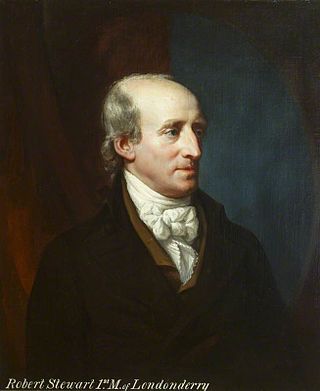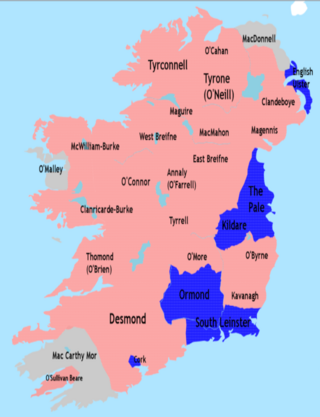Contents
| |||||
| Centuries: | |||||
|---|---|---|---|---|---|
| Decades: | |||||
| See also: | Other events of 1606 List of years in Ireland | ||||
Events from the year 1606 in Ireland.
| |||||
| Centuries: | |||||
|---|---|---|---|---|---|
| Decades: | |||||
| See also: | Other events of 1606 List of years in Ireland | ||||
Events from the year 1606 in Ireland.
James Hamilton, 1st Earl of AbercornPC (S) (1575–1618) was a Scottish diplomat for James VI and an undertaker in the Plantation of Ulster, Ireland.

Robert Stewart, 1st Marquess of LondonderryPC (Ire) (1739–1821), was a County Down landowner, Irish Volunteer, and member of the parliament who, exceptionally for an Ulster Scot and Presbyterian, rose within the ranks of Ireland's "Anglican Ascendancy." His success was fuelled by wealth acquired through judicious marriages, and by the advancing political career of his son, Viscount Castlereagh. In 1798 he gained notoriety for refusing to intercede on behalf of James Porter, his local Presbyterian minister, executed outside the Stewart demesne as a rebel.

The Flight of the Earls took place in September 1607, when Hugh O'Neill, 2nd Earl of Tyrone, and Rory O'Donnell, 1st Earl of Tyrconnell, and about ninety followers, left Ulster in Ireland for mainland Europe. Their permanent exile was a watershed event in Irish history, symbolizing the end of the old Gaelic order.

The title of Earl of Ulster has been created six times in the Peerage of Ireland and twice in the Peerage of the United Kingdom. Since 1928, the title has been held by the Duke of Gloucester and is used as a courtesy title by the Duke's eldest son, currently Alexander Windsor, Earl of Ulster. The wife of the Earl of Ulster is known as the Countess of Ulster. Ulster, one of the four traditional provinces of Ireland, consists of nine counties: six of these make up Northern Ireland; the remainder are in the Republic of Ireland.

The House of Burgh or Burke was an ancient Anglo-Norman and later Hiberno-Norman aristocratic dynasty who held the earldoms of Kent, Ulster, Clanricarde, and Mayo at various times, provided Queen Consorts of Scotland and Thomond; many Kings of Britain and multiple other royals, and played a prominent role in the Norman invasion of Ireland.

Walter de Burgh, 1st Earl of Ulster, 2nd Lord of Connaught also spelt Burke or Bourke, was an Irish peer from the House of Burgh.

The Nine Years' War, sometimes called Tyrone's Rebellion, took place in Ireland from 1593 to 1603. It was fought between an Irish confederation—led mainly by Hugh O'Neill of Tyrone and Hugh Roe O'Donnell of Tyrconnell—against English rule in Ireland, and was a response to the ongoing Tudor conquest of Ireland. The war began in Ulster and northern Connacht, but eventually engulfed the entire island. The Irish alliance won numerous victories against the English forces in Ireland, such as the Battle of Clontibret (1595) and the Battle of the Yellow Ford (1598), but the English won a pivotal victory against the alliance and their Spanish allies in the siege of Kinsale (1601–02). The war ended with the Treaty of Mellifont (1603). Many of the defeated northern lords left Ireland to seek support for a new uprising in the Flight of the Earls (1607), never to return. This marked the end of Gaelic Ireland and led to the Plantation of Ulster.

Killyleagh Castle is a castle in the village of Killyleagh, County Down, Northern Ireland. It is believed to be amongst one of the oldest inhabited castles in the country, with parts dating back to 1180. It follows the architectural style of a Loire Valley château, being redesigned by architect Sir Charles Lanyon in the mid-19th century. It has been owned by the Hamilton family since the early 17th century.
Sir George Hamilton, 1st Baronet of Donalong and Nenagh, born in Scotland into a Catholic family, inherited land in Ireland and served his brother-in-law, the 1st Duke of Ormond, a Protestant, in diplomatic missions during the Confederate Wars and as receiver-general of the royalists. He also defended Nenagh Castle against Henry Ireton during the Cromwellian conquest of Ireland. Hamilton was father of Antoine Hamilton, author of the Mémoires du Comte de Grammont, of Richard Hamilton, Jacobite general, and of Elizabeth, Countess de Gramont, "la belle Hamilton".
Sir Hugh Montgomery, 1st Viscount Montgomery of the Great Ards was an aristocrat and a soldier, known as one of the "founding fathers" of the Ulster-Scots along with Sir James Hamilton, 1st Viscount Claneboye. Montgomery was born in Ayrshire at Broadstone Castle, near Beith. He was the son of Adam Montgomery, the 5th Laird of Braidstane, by his wife and cousin Margaret Montgomery of Hessilhead.

Sir Frederick Hamilton was a Scottish soldier who fought for Sweden in the Thirty Years' War in Germany and for the Covenanters in Ireland, Scotland, and northern England. He built Manorhamilton Castle, County Leitrim, Ireland. His son Gustavus became the 1st Viscount Boyne.
Events from the year 1689 in Ireland.
Events from the year 1607 in Ireland.
James Hamilton, 1st Viscount Claneboye was a Scot who became owner of large tracts of land in County Down, Ireland, and founded a successful Protestant Scots settlement there several years before the Plantation of Ulster. Hamilton was able to acquire the lands as a result of his connections with King James I, for whom he had been an agent in negotiations for James to succeed Queen Elizabeth I.

Gustavus Hamilton, 1st Viscount BoynePC (Ire) (1642–1723) was an Irish soldier and politician. In his youth, he fought in his cousin Sir George Hamilton's regiment for the French in the Franco-Dutch War. About 1678 he obtained a commission in the Irish Army. James II appointed him to the Irish Privy Council in 1685.
Alexander MacDonnell, 3rd Earl of AntrimPC (Ire) (1615–1699) was a Catholic peer and military commander in Ireland. He fought together with his brother Randal on the losing side in the Irish Confederate Wars (1641–1653); and then, having succeeded his brother as the 3rd Earl of Antrim in 1683, fought in the Williamite War (1688–1691), on the losing side again. Twice he forfeited his lands and twice he regained them.

William Stewart, 1st Viscount Mountjoy (1653–1692), was an Anglo-Irish soldier.

Richard Óg de Burgh, 2nd Earl of Ulster and 3rd Baron of Connaught, called The Red Earl, was one of the most powerful Irish nobles of the late 13th and early 14th centuries and father of Elizabeth, wife of King Robert the Bruce of Scotland.
Events from the year 1623 in Ireland.
Events from the year 1591 in Ireland.